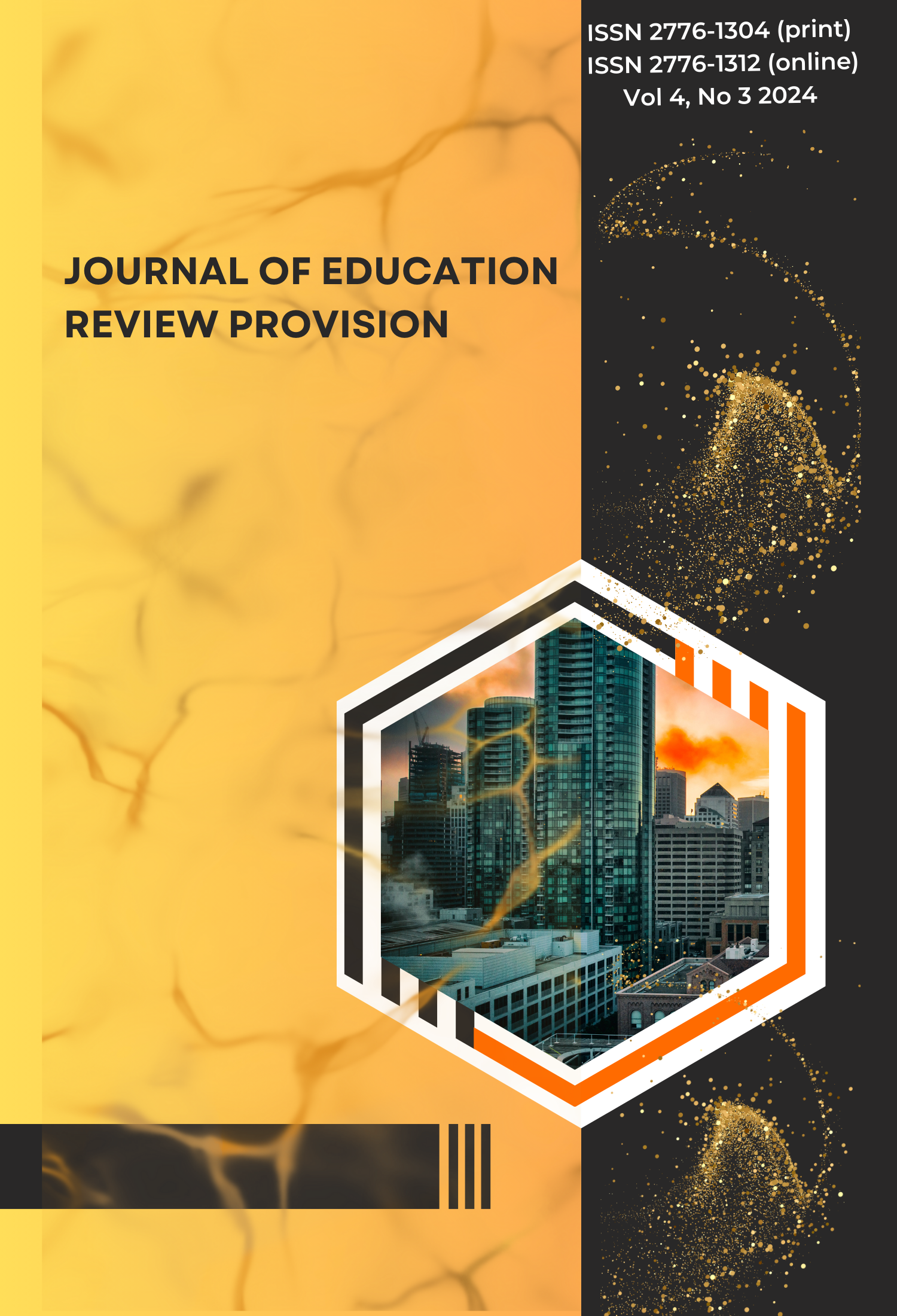Learning to Analyze the Structure and Language of Anecdotal Texts through the Discovery Learning Method nd the Student Visual Audio Media
DOI:
https://doi.org/10.55885/jerp.v4i3.472Keywords:
Life Skills Education, Youth Empowerment, Success Indicators, Intervention EffectivenessAbstract
This paper aims to: (1) Describe the planning, implementation, and assessment of learning with the analysis of the structure and language of anecdotal texts through the discovery learning method and audio visual media; and (2) describe the ability of class X IPS students.1 Analyze the structure and language of anecdotal texts through the discovery learning method and audio visual media. The method used in this study is descriptive-qualitative method. This method is used to describe and present data as it is about the results of research on learning to analyze the structure and happiness of anecdotal texts through the discoveryarning method and audio visual media class X IPS.1 SMA Negeri 1 Boliyohuto. Data collection techniques used in this study are observation techniques, interview techniques, documentation techniques, and test techniques. Data analysis techniques consist of procedures, (1) identify student activities, teachers, learning methods and media used, and the ability of students to analyze the structure and language of anecdotal texts; (2) classifying student learning outcomes in analyzing the structure and language of anecdotal text based on the score category; (3) assessing student learning outcomes in analyzing the structure and language of anecdotal texts; and (4) concluding the results of data analysis. The results of this study indicate that the ability of students in analyzing the structure and language of anecdotal texts has increased. This can be seen from the activity of analyzing the structure of anecdotal text which obtains a value of 90.16 and the language gains a value of 77.60, so that the ability of students to analyze the structure and language of anecdotal text obtained an average value of 83.88. the ability to analyze the structure and language of anecdotal text through the discovery learning method and audio visual media students of class X IPS.1 SMA Negeri I Boliyohuto Tahuan Tahuan 2017/2018 lessons have increased.References
Alam, A. (2022). Social robots in education for long-term human-robot interaction: socially supportive behaviour of robotic tutor for creating robo-tangible learning environment in a guided discovery learning interaction. ECS Transactions, 107(1), 12389. https://doi.org/10.1149/10701.12389ecst
Baker, B., Polikar, S., & Homayounzadeh, M. (2021). “I Was Not Thoughtful Enough Before”: Exploiting the Learning-Oriented-Assessment Potential of a Test-Taker-Oriented Rubric for Summative Assessment. In Learning-Oriented Language Assessment (pp. 162-181). Routledge.
Chen, Y., Jensen, S., Albert, L. J., Gupta, S., & Lee, T. (2023). Artificial intelligence (AI) student assistants in the classroom: Designing chatbots to support student success. Information Systems Frontiers, 25(1), 161-182. https://doi.org/10.1007/s10796-022-10291-4
Dewi, E. R., & Alam, A. A. (2020). Transformation model for character education of students. Cypriot Journal of Educational Sciences, 15(5), 1228-1237.
Guan, J., Wang, G., Wang, J., Zhang, Z., Fu, Y., Cheng, L., ... & Deng, H. (2022). Chemical reprogramming of human somatic cells to pluripotent stem cells. Nature, 605(7909), 325-331. https://doi.org/10.1038/s41586-022-04593-5
Kitano, H. (2021). Nobel Turing Challenge: creating the engine for scientific discovery. NPJ systems biology and applications, 7(1), 29. https://doi.org/10.1038/s41540-021-00189-3
Kremzer, V. (2023). Academic reflective writing or anecdotal storytelling: a study on pre-service EFL teaching portfolios. European Journal of Teacher Education, 46(4), 580-604. https://doi.org/10.1080/02619768.2021.1961735
Kwangmuang, P., Jarutkamolpong, S., Sangboonraung, W., & Daungtod, S. (2021). The development of learning innovation to enhance higher order thinking skills for students in Thailand junior high schools. Heliyon, 7(6).
Lake, B. B., Menon, R., Winfree, S., Hu, Q., Melo Ferreira, R., Kalhor, K., ... & Jain, S. (2023). An atlas of healthy and injured cell states and niches in the human kidney. Nature, 619(7970), 585-594. https://doi.org/10.1038/s41586-023-05769-3
Lipman, P. (2023). Beyond accountability: Toward schools that create new people for a new way of life. In The critical pedagogy reader (pp. 586-605). Routledge.
Melzi, G., Schick, A. R., & Wuest, C. (2023). Stories beyond books: teacher storytelling supports children’s literacy skills. Early Education and Development, 34(2), 485-505. https://doi.org/10.1080/10409289.2021.2024749
Panadero, E., & Jonsson, A. (2020). A critical review of the arguments against the use of rubrics. Educational Research Review, 30, 100329. https://doi.org/10.1016/j.edurev.2020.100329
Rahiem, M. D. (2021). Storytelling in early childhood education: Time to go digital. International Journal of Child Care and Education Policy, 15(1), 4. https://doi.org/10.1186/s40723-021-00081-x
Ramesh, T. R., Lilhore, U. K., Poongodi, M., Simaiya, S., Kaur, A., & Hamdi, M. (2022). Predictive analysis of heart diseases with machine learning approaches. Malaysian Journal of Computer Science, 132-148. https://doi.org/10.22452/mjcs.sp2022no1.10
Sarı, U., Duygu, E., Şen, Ö. F., & Kırındı, T. (2020). The Effects of STEM education on scientific process skills and STEM awareness in simulation based ınquiry learning environment. Journal of Turkish Science Education, 17(3), 387-405. https://doi.org/10.36681/
Sarker, I. H. (2022). AI-based modeling: techniques, applications and research issues towards automation, intelligent and smart systems. SN Computer Science, 3(2), 158. https://doi.org/10.1007/s42979-022-01043-x
Sipayung, K. T., Tampubolon, S., Napitupulu, F. D., & Tobing, F. L. (2021). Generic structure of descriptive text written English language learner and teachers. Linguistics and Culture Review, 5(S3), 1636-1650. https://doi.org/10.21744/lingcure.v5nS3.1950
Suchyadi, Y., & Suharyati, H. (2021). The Use of Multimedia as An Effort to Improve the Understanding Ability of Basic School Teachers ‘Creative Thinking in The Era ‘Freedom of Learning,’. Yogyakarta: Zahir Publishing, 42-53.
Sutarto, S., Sari, D. P., & Fathurrochman, I. (2020). Teacher strategies in online learning to increase students’ interest in learning during COVID-19 pandemic. Jurnal Konseling Dan Pendidikan, 8(3), 129-137.
Zimmerman, B. J. (2023). Dimensions of academic self-regulation: A conceptual framework for education. In Self-regulation of learning and performance (pp. 3-21). Routledge.
Downloads
Published
How to Cite
Issue
Section
License
Copyright (c) 2024 Journal of Education Review Provision

This work is licensed under a Creative Commons Attribution-ShareAlike 4.0 International License.
Journal of Education Review Provision operates under articles of this journal licensed under a https://creativecommons.org/licenses/by/4.0. This allows for the reproduction of articles, free of submissions charge, with the appropriate citation information. All authors publishing with the Journal of Education Review Provision accept these as the terms of publication.











